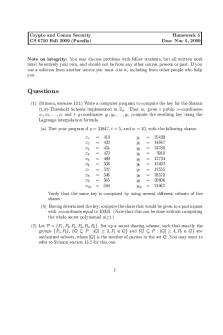Seminar assignments - S12b-Thermo-Problems (Brayton) PDF

| Title | Seminar assignments - S12b-Thermo-Problems (Brayton) |
|---|---|
| Author | Manuel Meco Gomez |
| Course | Thermal Engineering |
| Institution | Universidad Carlos III de Madrid |
| Pages | 2 |
| File Size | 137.4 KB |
| File Type | |
| Total Downloads | 32 |
| Total Views | 119 |
Summary
S12b-Thermo-Problems (Brayton)...
Description
Power generation cycles: Brayton Cycle 6.1 Plot in a T-s diagram, an ideal Carnot cycle operating between a reservoir at 40ºC and a reservoir at 1200ºC. Determine the efficiency. Plot a Brayton cycle operating between the same temperatures (Tmin=40ºC and Tmax=1200ºC). T
T
s
s
Carnot cycle
Ideal Brayton cycle
Which one has a higher efficiency? Why? Sol: 0.79 6.2 1) Plot a Brayton cycle in a T-s diagram and draw the schematic containing the different devices that constitute the cycle numbering the characteristic points of the cycle. 2) Determine the efficiency for a compression ratio equal to 12. 3) For an inlet turbine temperature of 1300K determine the turbine exit temperature. Additional data: Assume all the processes as ideal. The working fluid is air, assumed as ideal gas with constant specific heats and =1.4. Sol: 0.51; 639 K 6.3 The following schematic represents a gas turbine consisting of a compressor (C), a combustion chamber (CC) and a power turbine (T).
. Qcc 2
3 C.C.
. Wn C 1
T 4
1
Installation data: The whole system works at steady state conditions and there are not pressure drops in the pipes of the system. Kinetic and potential energy changes can be neglected. After combustion, the exhaust gases will be considered air. It can also be assumed that the mass flow rate of the exhaust gases after combustion are both equal to the mass flow rate of air before the combustion, hence, neglecting the fuel mass flow rate Compressor (C):
Turbine (T):
-
Adiabatic;
- Adiabatic;
-
Inlet pressure: P1=1 bar
- Exit pressure: P4= 1 bar
Combustion chamber (CC):
- Exit gas temperature T4=900 K - Isentropic efficiency: 0,9
- Constant pressure.
Net power output: W NET 1 MW
- Burner efficiency: 0,95
Back work ratio: RW=0,5
- Lower heating value of the fuel: 40 MJ/kg - fuel to air ratio: 0,024 - Fuel mass flow rate: 0,08 kg/s
Properties of the working fluid: ideal gas with constant specific heats. Rg=0,287 kJ/(kg·K); γ=1,4 1.- Determine the heat rate transferred to the working fluid in the combustion chamber and the mass flow rate of air in the cycle. 2.- Determine the power developed by the turbine and the power consumed in the compressor. 3.- Determine the air temperature at the turbine inlet (3). 4.- What would be the power developed by a reversible turbine? Taking the temperature calculated in the previous question as the inlet temperature, what would be the exit temperature of the gases in this case? 5.- Determine the pressure ratio in the turbine. 6.- Determine the combustion chamber inlet temperature (T2). 7.- Determine the ambient temperature (T1) (compressor inlet temperature). 8- Determine the isentropic efficiency of the compressor. 9.- Determine the compressor exit temperature if the compressor is assumed ideal. 10- Plot the real and the ideal cycle in a T-s diagram. Indicate the constant pressure lines with their values and the temperature of the different points in the diagram. Sol: 3 MW, 3.3 kg/s; 2 MW, 1 MW; 1506 K; 2.2 MW, 839 K; 7.75; 597 K; 294 K; 0.77; 528 K. 2...
Similar Free PDFs

Seminar assignments
- 3 Pages

Seminar assignments
- 11 Pages

Seminar assignments - Assignment 15
- 11 Pages

Seminar assignments - Tax shield
- 1 Pages

Seminar assignments - Skew test
- 3 Pages

Seminar assignments ass1-14
- 2 Pages

Seminar assignments - everest report
- 15 Pages

Seminar assignments - Homework 5
- 1 Pages

Seminar assignments - report#1
- 3 Pages

Seminar assignments - And solutions
- 50 Pages

Seminar assignments - assignment 2
- 12 Pages

Seminar assignments Homework 14
- 3 Pages

Seminar assignments - Quiz 5
- 9 Pages
Popular Institutions
- Tinajero National High School - Annex
- Politeknik Caltex Riau
- Yokohama City University
- SGT University
- University of Al-Qadisiyah
- Divine Word College of Vigan
- Techniek College Rotterdam
- Universidade de Santiago
- Universiti Teknologi MARA Cawangan Johor Kampus Pasir Gudang
- Poltekkes Kemenkes Yogyakarta
- Baguio City National High School
- Colegio san marcos
- preparatoria uno
- Centro de Bachillerato Tecnológico Industrial y de Servicios No. 107
- Dalian Maritime University
- Quang Trung Secondary School
- Colegio Tecnológico en Informática
- Corporación Regional de Educación Superior
- Grupo CEDVA
- Dar Al Uloom University
- Centro de Estudios Preuniversitarios de la Universidad Nacional de Ingeniería
- 上智大学
- Aakash International School, Nuna Majara
- San Felipe Neri Catholic School
- Kang Chiao International School - New Taipei City
- Misamis Occidental National High School
- Institución Educativa Escuela Normal Juan Ladrilleros
- Kolehiyo ng Pantukan
- Batanes State College
- Instituto Continental
- Sekolah Menengah Kejuruan Kesehatan Kaltara (Tarakan)
- Colegio de La Inmaculada Concepcion - Cebu


